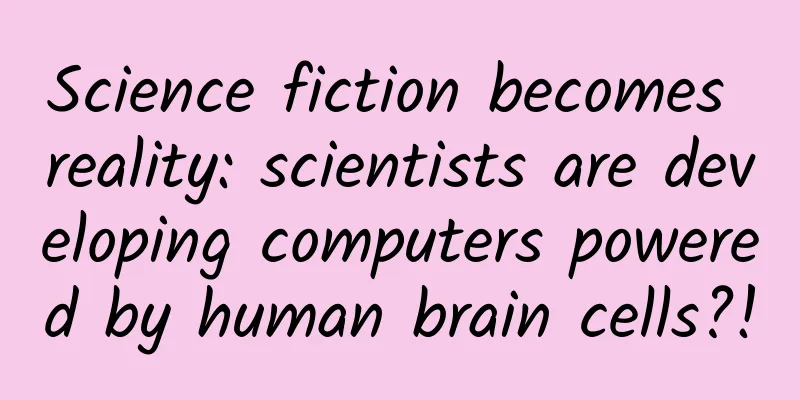Science fiction becomes reality: scientists are developing computers powered by human brain cells?!

|
Audit expert: Zheng Yuanpan, professor at Zhengzhou University of Light Industry The field of artificial intelligence has been extremely lively recently. A number of AI (Artificial Intelligence) products, led by Chat GPT (Chat Generative Pre-trained Transformer), have set off a craze on the Internet, constantly refreshing netizens' cognition with their powerful performance, making many people believe that the era when AI changes the world is coming. However, some scientists have suggested that current human computer technology has reached a bottleneck and the development of AI will be restricted. They have proposed the concept of organoid intelligence (OI), and said that if OI can be realized in the future, it is very likely that the "strong artificial intelligence" in science fiction movies will become a reality. AI, GPT and Strong Artificial Intelligence Before we learn about OI, let's first talk about AI, which is gaining popularity. AI is artificial intelligence, which was first formally proposed at the Dartmouth Conference in 1956. It is a simulation of human consciousness and thinking process, and is a means for humans to understand the essence of intelligence. Professor Winston defines AI as "the study of how to make computers do intelligent work that only humans could do in the past." Source: pixabay After decades of development, AI has been widely used in our daily lives. For example, the intelligent voice assistants on mobile phones, face recognition that often appears in authentication, and information push when surfing the Internet are all inseparable from the participation of AI. It also plays an important role in high-tech fields such as medicine, logistics, production, and transportation. Even in some fields where it is generally believed that AI cannot replace humans, such as painting and composition, AI has begun to penetrate. The completion of its works is amazing and even won unanimous praise from the judges. AI work "Space Opera" At an art competition held at the Colorado State Fair in 2022, a painting titled "Space Opera" won the Digital Art Award. The painting was created by a local designer named Jason Allen using artificial intelligence and then retouched using Photoshop. The award of this work also caused considerable controversy in the local art circle. ChatGPT is a deep learning model for text generation based on Internet available data training , and has been updated to GPT-4. GPT-4's knowledge covers almost all disciplines, and can generate texts with standard grammar and strict logic, as well as create paintings. It can even achieve extremely high scores in some of the most difficult human exams, such as the SAT (Scholastic Assessment Test, commonly known as the American college entrance examination) and the judicial examination. It is so powerful that it is amazing. At present, all artificial intelligence is still at the stage of weak artificial intelligence . Strong artificial intelligence, also known as multiple intelligence , refers to artificial intelligence with complete intelligence, capable of autonomous reasoning and thinking. It is believed to be able to produce perception and consciousness, and is a new goal for the development of AI. Some people believe that strong artificial intelligence may never be realized, but the emergence of the concept of OI has brought hope to multiple intelligence. OI may be able to develop complete strong artificial intelligence by directly simulating the structure, thinking mode, and learning mode of the human brain. What is OI? Many people believe that the emergence of ChatGPT marks a singularity in the development of artificial intelligence, which will usher in a blowout development of the industry. However, some sharp-eyed scientists believe that today's computer technology and artificial intelligence technology are infinitely close to a bottleneck - because it is difficult for humans to install more transistors on chips. In fact , for humans, the human brain is the most complex intelligent system , and the essence of artificial intelligence is also the simulation of the human brain's thinking process. So is it possible to directly create a "brain"? In February 2023, Thomas Hartung's team at Johns Hopkins University proposed the concept of organoid intelligence, or OI, in an effort to use this theory to develop more powerful, efficient, and energy-efficient forms of computers in the future. An organoid is an organ model that is highly similar to an organ or tissue source in the body and is cultivated through a 3D in vitro cell culture system. Although it is not a real organ, it has some of the functions of the original organ. Source: pixabay OI uses similar technology to culture brain cell tissue in vitro, and uses it as the core hardware of a biological computer - the CPU and graphics card. It then connects to external electronic devices through microelectrode arrays and other means for training and calculations. In December 2022, Australian biotech startup Cortical Labs used human stem cells to induce differentiation of human neurons, and integrated these neurons with multi-electrode array computers to form a combination of a human brain and a computer. They then used the microelectrode array to let it play a "ping pong" game, and the neurons learned the operation of the game in just five minutes. An artificial neural network of similar size may take 90 minutes. Source: pixabay Since organoid intelligence is based on biological hardware, one of the biggest advances is reduced power consumption. The core hardware device of OI can almost be regarded as another brain, and the power consumption of the brain is extremely low. The average power consumption of an adult brain is only 20W, while the power consumption of most AI servers is usually around 10^6W. Some top supercomputers, such as my country's Sunway TaihuLight supercomputer, consume up to 15.37MW (megawatts). In addition, OI also has extremely strong deep learning capabilities. OI understands learning better than AI Because OI has the organizational structure of the human brain, it can achieve "few sample learning" and its ability to handle complex problems is far superior to traditional AI. If you want to identify a simple thing, the human brain only needs about 10 samples to learn it, but in the early days, AI still couldn't learn it even after "learning" millions of samples. AlphaGo, which defeated the world's top Go player Lee Sedol, was "fed" with nearly 160,000 game data . With such a large amount of training, a professional player would need about 37 years of training even if he did not eat or drink every day. The human brain has a very complex neural network, just like a super multi-core processor. The human brain's thinking area is mainly concentrated in the cerebral cortex, which has about 14 billion neurons and can generate 1014~1015OPS (Operations per second), which is hundreds of thousands of times the computing power of ordinary computers (1010 OPS). With such powerful computing power and a highly complex neural network structure, the human brain has evolved a multi-layered deep learning model. This model allows humans to efficiently learn and process various complex problems, with an efficiency that is millions of times that of computers. At the same time, after the human brain learns one thing, the experience, strategies, methods, etc. can be applied to other things . For example, the thinking mode and methodology we develop by learning Go can also be used in other projects such as basketball and football, while if AI wants to learn a new skill, it must start from scratch. Source: hippopx There is no doubt that OI is a forward-looking technology that will take decades to realize. Some scientists have also raised ethical issues, such as how to protect privacy rights, follow ethical norms, and respect human values. Solving these problems also requires process and time. In the future, if OI can be truly realized, it may set off a new wave of craze in the field of artificial intelligence. By then, it may really be possible to realize strong artificial intelligence with perception and consciousness as shown in science fiction movies. |
<<: Can a drug be used to “eliminate” bacteria at a specific point? Does such a drug really exist?
Recommend
Practical information | A comprehensive review of Toutiao products and strategy optimization
In recent years, Toutiao has developed rapidly, a...
In addition to SEM promotion, why do we need to invest in native advertising?
The key differences between native advertising an...
Poppy looks like a vegetable and you can't really tell them apart? Be careful not to break the law!
recently Public Security Bureau of Dangyang City,...
A complete event operation and promotion!
All operating systems and organizations are only ...
Uncle Wolf’s Zhihu Precision Traffic Drainage 9.0 Training Course
There are 21 videos in total of Uncle Wolf’s Zhih...
Which mosquito repellent product is the safest and most effective?
Mosquitoes are around every year, how can we avoi...
What would you most like to do if it snows? Do science popularization! | Expo Daily
Your best "insider" in the scientific c...
Insiders revealed that Tesla is developing a new battery pack with a maximum range of 640 kilometers
Due to the objective reality of battery capacity,...
How long can the huge profits of auto finance last?
If selling cars is not profitable, what will the ...
The valuation impulse behind Xiaomi, Meizu, and Hammer's concentration on the low-end
Yesterday, Smartisan released its 1,000-yuan smar...
How to Say Goodbye to the Yellow Screen on iPhone 6s and iPhone 7?
In the past one or two years, the color temperatu...
Graphics card says goodbye to external power supply PCI-E 4.0 supports up to 500W
During the Intel IDF conference, we saw some comp...
Ping An Health Product Analysis
At present, there are more than 3,000 certified m...
A 1-year-old girl was poisoned by a rare and severe poison. Be careful! 1g can be fatal, and there is no specific medicine...
Thallium is a rare heavy metal Usually in profess...
Android source code download: APP startup guide
Functional classification: Tools Supported platfo...









